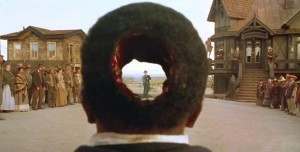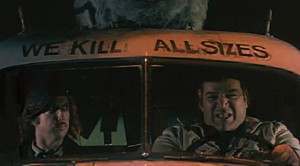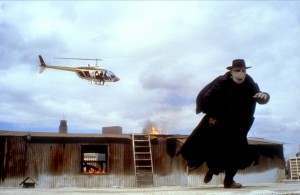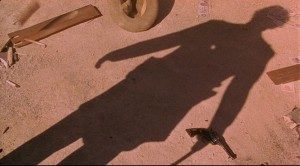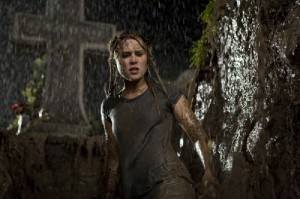Sam Raimi began his career making low-budget horror films such as The Evil Dead (1993) before moving to expensive blockbusters such as Spider-Man (2002), Spider-Man 2 (2004) and Spider-Man 3 (2007). Raimi’s long movie-making career also encompasses award-winning thrillers such as A Simple Plan (1998) and cult-movies such as Army of Darkness (1993). In 1999, he also made the baseball love-story, For Love of the Game.
But like virtually all filmmakers, Raimi’s career has also included several films that — for whatever reason — didn’t garner the popular or critical success of others, even though they were quite good, or at the very least, inventive and ambitious.
With that thought in mind, I present my list of Sa Raimi’s top five underrated films (in chronological order).
Crimewave (1985)
This film, originally known as The XYZ Murders, was taken out of Raimi’s hands late in the process, and consequently disowned by the director. And yet, there’s nothing in the world like Crimewave: an ambitious (if flawed…) movie that is a deliberate blend of 1940s film noir and The Three Stooges oeuvre.
Crimewave depicts (in flashback…) the story of a schmuck named Vic (Reed Birney) who is wrongly accused of murder and, on the night of his execution at Hudsucker Penitentiary, recounts his tale of woe.
Although it strives to find a consistent tone, Crimewave goes for broke with incredibly inventive (if bizarre) set-pieces like “The Parade of Protection: The Safest Hallway in the World,” and features scene stealing “exterminators” Brion James and Paul Smith, who seem piped in directly from Three Stooges movies such as Ants in the Pantry (1936) and Termites of 1938 (1938).
I’m not claiming that the movie is great, or without abundant flaws, only that Crimewave reveals Raimi’s talent in creating humor out of unusual visualizations. The film is a living, breathing cartoon, and on that basis should be seen at least one.
Darkman (1990)
This 1990 superhero film — a deft mixture of the characters Batman and Phantom of the Opera — may just be Raimi’s greatest superhero film.
Darkman’s premise involves a scientist, Peyton Westlake (Liam Neeson) who is working on the creation of synthetic flesh. A millionaire businessman, Strack (Colin Friels), and his henchman, Durant (Larry Drake), destroy Westlake’s laboratory, however, while trying to recover a secret memorandum left there by Westlake’s fiancée, Julie (Frances McDormand). Peyton survives the fiery blast, but is left horribly scarred and burned. A surgeon disconnects his pain receptors, making him incredibly strong…and even fearless.
Setting out for vengeance, Darkman uses his synthetic flesh (which lasts only 99 minutes…) to take down Strack and Durant.
Darkman is legitimately darker than Burton’s Batman and suggests that the price of vengeance — at least for Westlake — is his humanity. Perhaps even his sanity too. The film holds up remarkably well today, and one critic, David Edelstein called it a “melancholy symphony for orchestra and whoopee cushion.” The film’s climactic helicopter set-piece over Los Angeles actually plays better than does its 1999 counterpart in The Matrix.
Darkman thrives, perhaps, because Westlake’s obsession carries such a cost. He loses his fiancé, and his wife. It’s harder to take brooding heroes like Bruce Wayne or Peter Parker so seriously, after seeing what Peyton endures to fulfill his wrath. Many contemporary histories of the cinematic superhero form neglect to mention Darkman, or its impact on a genre in ascent.
The Quick and the Dead (1995)
This unconventional Western starring Sharon Stone, Russell Crowe, Gene Hackman, Leonardo Di Caprio and Lance Henriksen was largely dismissed by critics upon release, but remains a stylish tour-de-force.
The Quick and the Dead’s central conceit — a quick-draw contest in a corrupt frontier town — permits for uber-formalist Raimi to go whole hog in terms of visual flourishes since he essentially re-stages the same sequence of events (the shoot-out) again and again. Furthermore, the cast of characters in the film is remarkably colorful, with Henriksen’s charming Ace Hanlon proving a dynamic stand-out.
Like Darkman, The Quick and the Dead is a tale of vengeance wrought, and of an outsider (in this case Stone’s gunslinger) who brings down a corrupt establishment. But all the old and leathery Western tropes are given new life because of Raimi’s unconventional eye. One composition, –which features a spot of sunlight shining through a standing gunfighter’s perforated body — will make you stand up and cheer at its pre-CGI audacity and ingenuity.
More to the point, perhaps, by staging and re-staging the gunfight — a duel between two opponents of equal skill — Raimi’s steroidal western brilliantly burns the fat off a genre in decline.
Drag Me to Hell (2000)
Raimi’s return to the horror genre after nearly decade away reveals the director’s untiring sense of playfulness. The film revels in excessive gore, and delights in sequences which straddle the line between terror and humor.
Drag Me To Hell tells the story of Christine Brown (Alison Lohman), a loan officer at the Wilshire Pacific Bank. She runs afoul an old gypsy woman, Sylvia Ganush (Lorna Raver) who has fallen behind on her mortgage payments. The story quickly becomes a Great Recession morality when Ganush is humiliated by Christine, and a gypsy curse is unleashed upon the young woman.
Alas, the banking system that Christine is a part of requires her to make a deliberate selection between her humanity .and her employer’s bottom line. It’s a world in which decency and humanity don’t matter, in which those qualities are, in fact, looked upon as weaknesses, not strengths. Christine’s promotion hinges, particularly, on her ability to destroy the life and dignity of another human being, not her ability to help that human being.
Old Mrs. Ganush — part hyperactive Deadite and part taunting Wicked Witch of the West — warns Christine that “soon” the tables will be turned; that the unfortunate girl will be begging her for help. The curse she unleashes seems unstoppable.
Christine quickly finds herself in the very position of desperate Mrs. Ganush, with no one to help her; no higher authority to consult, and no place at all to turn. Christine requires $10,000 dollars (cash) in 24-hours to pay for the assistance of a medium.
Accordingly, she must pawn all of her beloved middle-class belongings, from jewelry to electronic equipment, to childhood treasures. Now the shoe is truly on the other foot, and the person foreclosing on another person’s house sees her own “soul” being foreclosed upon by a merciless collector.
The message of Drag Me To Hell is that ours culture in which people don’t seem to believe that there is a spiritual price for our behavior here on Earth, a realm where making money is apparently the greatest moral value of all. Christine learns differently in the film, but Raimi doesn’t linger on didactic lessons, instead staging bizarre set-pieces –including one involving a sacrificial goat — that teeter-totter expertly from horror to comedy and back again.
Horror fans, for some reason, by and large didn’t take to Drag Me to Hell, perhaps because they still long for Raimi to turn his attentions to Evil Dead IV, but the film relentlessly crafts laughs and screams.
Oz: the Great and Powerful (2013)
Although it was a hit, Oz got middling reviews and many viewers seemed to dismiss it as another soulless CGI fantasy.
Nothing could be further from the truth.
To fully understand Oz The Great and Powerful, it’s necessary to understand Raimi’s creative approach, and the enduring fascination he boasts for the nuts-and-bolts aspects of the movie-making experiencing, the technology that makes mass entertainment of this sort possible in the first place. In short, the film’s central character, Oscar (James Franco), the Wizard of Oz, is in fact, a mirror image of Raimi.
Both men create what appears to be magic through the auspices of technology. They are both technological wizards, the kind who work wonders with light, smoke, gears and cogs, not to mention misdirection and sleight-of-hand. And, both the film and its director stand at the same unhappy career cross-roads. Oscar’s latest show in 1905 Kansas meets with cat-calls and tomato-throwing from unhappy audience members, and if you remember Raimi’s last blockbuster picture, Spider-Man 3 (2007), he’s roughly in the same boat.
So, the journey of the filmmaker and the journey of the film’s protagonist intersect. And the answer that resolves both crises rests in the “magic” of technology, the magic of the movies.
Furthermore, it should be noted that the epic fantasy of Oz is familiar material for Raimi. He once told another cinematic story about a con-man defending a kingdom from evil via the “magical” auspices of science. That film was titled Army of Darkness (1992).
Itself based on Twain’s A Connecticut Yankee in King Arthur’s Court (1889), Raimi’s Army of Darkness contains several parallels with Oz the Great and Powerful. In Army of Darkness, Bruce Campbell plays a modern day hero in King Arthur’s court, Ash. He is not terribly bright or brave, but Ash is a hero because he devises a strategy, using science, to defeat the army of the Deadites.
The key to that strategy is the book in the back of his death coaster Delta 88: a modern science textbook. Armed with science and the pre-existing belief/prophecy that he is somehow the people’s “Promised One,” Ash leads Arthur’s kingdom to victory over the Medieval Dead.
Notice how closely Oz The Great and Powerful tracks with that narrative. The lead character, Oscar, is not a traditional hero either, but a con-man and money-grubber. Furthermore, he is prophesized to bring freedom to the land, not as “The Promised One,” but as “The Wizard.” And finally, he leads the troops to battle by learning the lessons of another book, this time one called “Mastering Magic.” He brings 20th century “magic” — meaning the tricks of Thomas Edison, in particular — to a land without such technology.
Both stories concern how science — which appears “magic” to those who don’t understand it — can usurp the role of traditional religion/mysticism in a society controlled by tyrants. In both situations, mysticism only raises evil, whether the Deadites or the Wicked Witches. Science and technology, by contrast, are the stabilizing factors which restore order in both tales. In both stories, 20th century “magic” — science — makes life better.
In an age when some congressmen loudly proclaim that science and evolution are from “the pits of hell,” this is a message that bears repeating, and which is welcome in our mass entertainment. If viewed as a more family friendly remake of Army, or even as a metaphor for Sam Raimi’s career, Oz emerges as a remarkable — and in this day and age — subversive entertainment. It deserves a second look for those who lumped it in with CGI wastelands like Wrath of the Titans (2012) or Snow White and the Huntsman (2012).
Would you like to support Flashbak?
Please consider making a donation to our site. We don't want to rely on ads to bring you the best of visual culture. You can also support us by signing up to our Mailing List. And you can also follow us on Facebook, Instagram and Twitter. For great art and culture delivered to your door, visit our shop.
